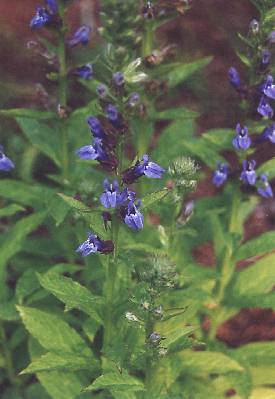Lobelia siphilitica
GREAT BLUE LOBELIA
Family: Campanulaceae
Quick Jumps
Growing Guide
Rainy Side Notes
GROWING GUIDE

Origin:
Eastern United States and Canada.
Plant Group:
Perennial.
Hardiness:
Sunset zones: 1-9, 14-17.
USDA zones: 4-8.
Heat zones: 8-1.
Mature size:
Height: 2-4 feet (60-120 cm).
Width: 12 inches (30 cm).
Flowering period:
Late summer to mid autumn.
Flowering attributes:
Long racemes of bright blue tubular flowers.
Leaf attributes:
Lance-shaped, hairy, light green leaves.
Growth habit:
Clump forming.
Light:
Full sun or partial shade.
Soil:
Fertile, moist soil.
Feeding:
Fertilize in spring with a complete organic fertilizer and again in June.
Propagation Methods:
Sow seed as soon as ripe. | Divide in spring.
Rainy Side Notes
I am a fan of almost any blue flower, and in my opinion Lobelia siphilitica is one of the handsomest, although some consider it to look weedy. A native to the eastern section of North America, according to the USDA this wildflower is considered endangered in Massachusetts and vulnerable to exploitation in New York, while in Maine it may possibly be extinct. It is sad to see these plants endangered in areas of our continent.
Considered toxic in modern times, the Cherokee and Iroquois once used it medicinally for many ailments. The Meskwaki believed that chopping up the roots and placing them in a quarreling couple's food would ward off divorce by helping them fall in love again.
This species grows next to ponds and other wet places in woods or meadows. In our summer-drought regions in the West, perennial lobelias need continually moist soil to thrive. Although we can grow it in full sun, hotter regions may need more shade. It’s an exceptional perennial for adding more blue to the late summer garden. However, it is a short-lived perennial, so you will need to divide plants every two to three years, to keep your garden stocked with these great blue beauties.
Photographed in author's garden.

Gardening for the Homebrewer: Grow and Process Plants for Making Beer, Wine, Gruit, Cider, Perry, and More
By co-authors Debbie Teashon (Rainy Side Gardeners) and Wendy Tweton
Copyright Notice | Home | Search | Perennials

